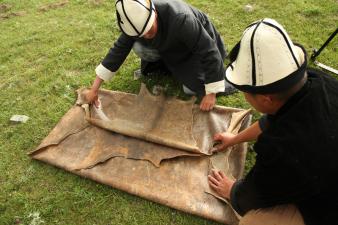EE00000432
 Traditional knowledge related to the technique of leather work and leather products manufacturing
Traditional knowledge related to the technique of leather work and leather products manufacturing
Historically, livestock herding has been one of the main livelihoods of the Kyrgyz people. That is why leather crafting has become an important craft and many household items are made out of leather. The skin of such domestic and wild animals as cows, horses, camels, yaks, sheep, goats, foxes, otters, mountain goats and deer is used for leathercraft. Sheep and goat skin is most widely used due to their accessibility. Sheep leather is used for making shoes and cloths.
In the context of nomadic and pastoral lifestyle, dishes made out of leather are still popular. The vessels for milk products such as sabaa, kookor, konok, konochok were made out of processed camel of cow skin. The vessels are smoked with juniper or pine branches before use. Cattle skin is used to make leather for some household items such as wooden chests for dishes and utensils, horse tack (stirrups, various strips, reigns and whips), etc.
Both women and men are engaged in leather work. At the same time there is a clear separation in labor. E.g. only men slaughter and skin animals. Men also process leather for horse tack and other large things. Women process skin of smaller animals such as sheep and goats. Women make such household items as vessels for milk products, various bags, sacks and cup-holders.
Kyrgyz people tried to decorate leather items just like any other household item. There were many ways to decorate leather items. E.g. cup-holders were decorated with silver clips or patterns were craved right on the surface of leather. Leather items were made in different shapes. E.g. kookor, a vessel for kymyz, was made in a shape of an anchor, cup holders were cylindrical or semi-spherical. Carving or stamping patterns on the leather surface looks very good because it livens up the monotonous surface and makes it more pleasing to eye.
Kyrgyzstan

